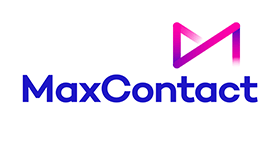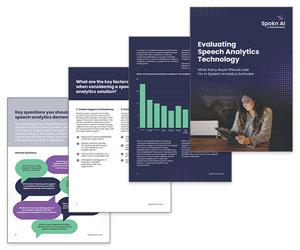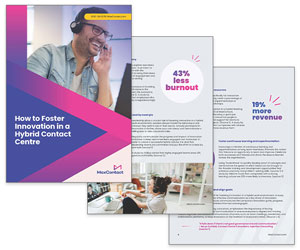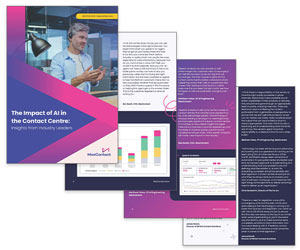MaxContact explores effective strategies that can help your call team connect with the right people consistently.
If you work in a contact centre that operates in the debt resolution industry, you’ll know that achieving a high right-party contact (RPC) rate is key to success. After all, how can you collect payments efficiently if you’re not speaking with the right recipient in the first place?
Despite this, MaxContacts recent benchmark report shows that many contact centres struggle to achieve optimal RPC rates. In fact, 23% of contact centres have a RPC rate below 20%, while the industry average sits at just 26%.
So, what can contact centre managers do to improve their RPC rates and ultimately, increase the percentage of debt collected?
What Is Right-Party Contact?
Right-party contact rates (RPCs) measure the percentage of calls where call agents connect with the intended recipient. In simple terms, it’s how often you get through to the right person.
Why Is Right-Party Contact Important for Debt Collection?
- Reaching the right person reduces frustration and increases customer satisfaction.
- High RPCs mean agents spend less time on unsuccessful calls, boosting efficiency.
- Increased RPCs lead to faster collections and reduced costs.
Challenges to Achieving High Right-Party Contact Rates
To improve right-party contact rates (RPCs), there are several common challenges that contact centres in the debt collection industry need to carefully consider and address.
Challenge 1: Poor Data Quality & Incorrect Information
Poor data quality is a common culprit of low right-party contact rates (RPCs). When contact information is incorrect, incomplete, or outdated, it becomes difficult to reach the intended recipient, leading to wasted time and resources.
Here are some examples of data quality oversights and their consequences:
- Oversight: Inaccurate or incomplete information due to data entry errors, system integration problems, or customer-provided data.
- Consequence: Difficulty reaching the intended recipient, wasted time and resources and reduced customer satisfaction.
- Oversight: Duplicate records for the same customer, once again caused by data entry errors or inconsistent data sources.
- Consequence: Confusion and inefficiency in call routing, resulting in unnecessary attempts to contact the same person.
- Oversight: Outdated contact information due to changes in addresses, phone numbers, or email addresses.
- Consequence: Failed attempts to reach customers, decreased efficiency and potential lost revenue.
Challenge 2: Inefficient Call Routing
Call routing is an invaluable tool – but only when used correctly. Inefficient call routing is another culprit of low RPCs. Here are some examples of the oversights contact centres often make with call routing and the impact on KPIs.
- Oversight: Call routing rules are not implemented properly or updated.
- Consequence: Calls are directed to the wrong agents or departments. Unnecessary transfers and delays lead to frustrated customers and negatively impacts agent efficiency.
- Oversight: Outdated call routing systems are not updated in real-time with information about agent availability, call volumes and customer preferences.
- Consequence: If a system is unaware of a sudden increase in call volume or an agent’s unavailability, it will continue to route calls to that agent, resulting in inefficient routing and longer wait times.
- Oversight: Agents aren’t trained to identify and route calls properly.
- Consequence: Untrained agents may misinterpret caller information, direct calls to the wrong departments, or transfer calls to agents ill-equipped to handle the customer’s query.
The Impact of Low Right-Party Contact Rates
Low right-party contact rates lead to increased costs, reduced customer satisfaction and potential compliance issues.
Let’s explore each one in more detail to understand the impact.
Increased Costs
- Inefficient call routing leads to agents spending time on unproductive calls, wasting resources and delaying debt recovery.
- Dealing with frustrated customers and repetitive tasks contributes to high agent turnover rates, increasing hiring and training costs.
Reduced Customer Satisfaction
- Difficulty reaching debtors can lead to missed payments and lower debt collected percentages.
- Negative customer experiences can tarnish a debt resolution company’s reputation, making it harder to collect debts in the future.
- Frustrated debtors may take legal action against debt resolution companies, leading to increased legal costs and potential reputational damage.
Potential Compliance Issues
The Financial Conduct Authority (FCA) has guidelines to treat customers fairly and reasonably. If contact centres fail to reach the right party, it can be seen as a breach of this requirement, leading to regulatory action, including fines or penalties.
Strategies for Improving Right-Party Contact Rates
How to Manage Data Accuracy and Quality
So we know the accuracy and quality of contact data impact right-party contact rates, but what strategies can call centres action to improve data?
| Strategy | Overview |
|---|---|
| Strategy 1: Implement a Data Cleansing and Validation Process | It’s important to regularly review and clean contact data to remove typos, inconsistencies and outdated information. Use data validation tools to ensure data is formatted correctly and adheres to specific standards. |
| Strategy 2: Enrich Contact Data | Supplement existing data with additional information, such as demographic details, preferences and recent interactions. This can help you tailor your outreach efforts and increase the likelihood of reaching the right person at the right time. |
| Strategy 3: Integrate with CRM Systems | Connect your contact centre software with your CRM system to access comprehensive customer information and ensure data consistency. This can help you avoid duplicate records and provide agents with a complete view of each customer’s interactions. |
| Strategy 4: Leverage Third-Party Data Sources | Supplement your existing data with information from third-party providers to improve targeting and accuracy. Consider using demographic data, credit bureau information, or social media data to enhance your understanding of customers. |
| Strategy 5: Establish Data Governance Policies | Develop clear policies and procedures for data management and quality. This includes regular data audits, data cleansing, and data retention guidelines. To ensure this is carried out effectively, all employees must be aware of and adhere to these policies. |
| Strategy 6: Combine Accurate Data with Automated Dialling | Automated dialler systems can reduce human error and improve call efficiency. However, accurate data is essential for these auto-diallers to function effectively and minimise wasted calls. |
| Strategy 7: Monitor Data Quality Metrics | Use analytics tools to track RPC rates, data accuracy and other relevant metrics. This will help you identify areas for improvement and make data-driven decisions to enhance your contact centre’s performance. |
How to Optimise Call Timing
Call timing plays a key part in improving right-party contact rates and debt recovery. Here are some effective strategies to enhance call timing.
| Strategy | Overview |
|---|---|
| Strategy 1: Introduce Predictive Dialling | Predictive dialling can automatically dial numbers based on predicted availability and considers factors such as past call history and customer behaviour. This reduces the time agents spend on unanswered calls and improves overall efficiency. |
| Strategy 2: Analyse Historical Data | Use analytics features to examine historical data and identify optimal calling times for debtor segments. Consider factors such as the day of the week, time of day and specific customer preferences when scheduling calls. |
| Strategy 3: Implement Skills-Based Call Routing | Skills-based call routing directs calls to agents with the appropriate skills and expertise to handle specific debt collection scenarios, such as dealing with difficult debtors or negotiating payment plans. Customers are connected with the best-qualified agents, improving their overall experience and increasing the likelihood of successful debt recovery. |
| Strategy 4: Use Intelligent Retry Strategies | Implement a system of intelligent retries to increase the chance of reaching debtors when calls go unanswered. Vary the time between call attempts based on factors such as the debtor’s history, the urgency of the debt and previous attempts. Consider omnichannel communication, such as email or text messages, to reach debtors who may not answer phone calls. |
How to Boost Call Agent Skills in Debt Collection
Agent training and development can improve right-party contact rates and enhance overall performance. Here are some ways you can deliver impactful training:
| Strategy | Overview |
|---|---|
| Strategy 1: Give Comprehensive Training | Train agents on customer data, contact strategies and communication skills, all tailored to debt collection. Utilise features such as call scripting and training on objection handling to equip agents with the tools they need to interact with customers effectively. |
| Strategy 2: Analyse Call Performance | Use speech analytics to analyse call transcripts and identify areas for improvement in agent performance. This can help you pinpoint areas where agents may need additional training or coaching. |
| Strategy 3: Prioritise Regular Feedback and Coaching | Offer regular feedback and coaching to agents based on their performance analysis. Address identified areas for improvement with tailored coaching, helping agents develop their skills and increase their confidence (and boost your retention rates). |
| Strategy 4: Track Additional KPIs | Monitor additional KPIs such as average handle time (AHT), average call rate (ACR), and customer satisfaction (CSAT) alongside RPC to gain a more comprehensive view of agent performance. These metrics can help you identify areas for improvement and measure the impact of your training and development efforts. |
Incorporating advanced outbound contact centre software is essential for achieving these goals. Features such as auto-diallers, speech analytics and reporting analytics can provide valuable insights and automation capabilities and help measure performance.
By investing in the right technology and implementing effective strategies, you can overcome the challenges highlighted in our benchmark report and achieve higher RPC rates.
Increase revenue, improve customer satisfaction and reduce operational costs, ultimately boosting the overall performance of debt resolution.
This blog post has been re-published by kind permission of MaxContact – View the Original Article
For more information about MaxContact - visit the MaxContact Website
Call Centre Helper is not responsible for the content of these guest blog posts. The opinions expressed in this article are those of the author, and do not necessarily reflect those of Call Centre Helper.
Author: MaxContact
Reviewed by: Megan Jones
Published On: 8th Oct 2024
Read more about - Guest Blogs, MaxContact






 MaxContact is customer engagement software that goes above and beyond to build smarter customer experiences. Our platform is packed with powerful features, accessible for businesses large and small, and ensures organisations can operate compliantly.
MaxContact is customer engagement software that goes above and beyond to build smarter customer experiences. Our platform is packed with powerful features, accessible for businesses large and small, and ensures organisations can operate compliantly. 











